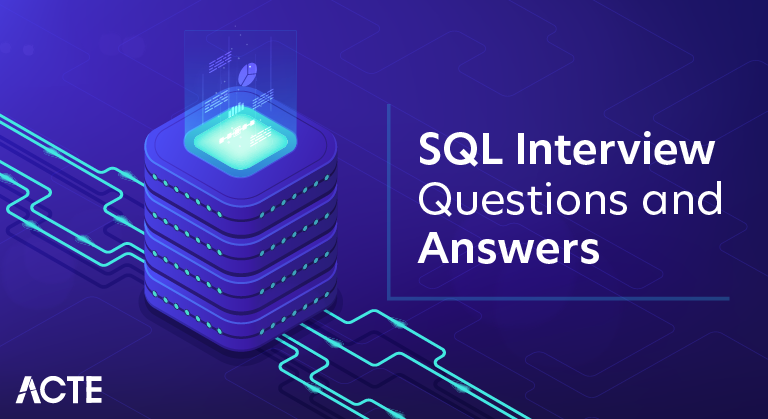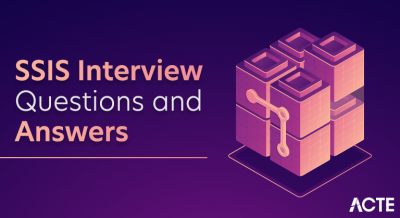
SQL (Structured Query Language) is an advanced and standardized computer language that is used to manage and manipulate relational databases. It is the communication backbone for relational database management systems (RDBMS) such as MySQL, PostgreSQL, Oracle, and Microsoft SQL Server. SQL enables users to create, retrieve, edit, and remove data from databases, making it a necessary tool for data-driven applications and enterprises. Its ease of use and adaptability make it a crucial expertise for developers, data analysts, and anybody involved in data management and storage.
1. What is SQL?
Ans:
SQL stands for Structured Query Language. It is a domain-specific language used for managing and manipulating relational databases. SQL serves as a standard interface for interacting with databases, allowing users to perform various operations, including data retrieval, insertion, modification, and deletion.
2. What types of SQL commands are there?
Ans:
- DDL (Data Definition Language) Commands
- DML (Data Manipulation Language) Commands
- DCL (Data Control Language) Commands
- TCL (Transaction Control Language) Commands
- Query Language Commands
- Utility Commands
3. Describe the differences between NoSQL and SQL databases.
Ans:
SQL: Relational databases or SQL databases employ a tabular, structured data model. A preset schema is used to arrange data into tables, and foreign keys are used to build links between the tables.
NoSQL: NoSQL databases offer various data models, including document-based, key-value, column-family, and graph databases. These models allow for more flexible and dynamic data structures.
4. What is a relational database?
Ans:
A relational database is a type of database management system (DBMS) that organizes and stores data in a structured and tabular format, consisting of tables with rows and columns. In a relational database, data is organized into multiple tables, each with a specific purpose, and relationships between these tables are established using keys.
5. What is a table in a database?
Ans:
Tables are a fundamental component of relational database management systems (RDBMS), and they play a crucial role in organizing and representing data in a structured and efficient manner.
6. How do you create a new database in SQL?
Ans:
The CREATE DATABASE statement is commonly used to create new databases in SQL, however the precise syntax and procedures might differ based on the DBMS you are using, such as MySQL, PostgreSQL, Microsoft SQL Server, or Oracle Database.
7. What is a primary key?
Ans:
A primary key is a crucial component in relational databases, serving as a unique identifier for each record within a table. It ensures that every row in the table has a distinct and non-null value, preventing duplicate or null entries.
8. What is a foreign key?
Ans:
A foreign key is a database constraint used to establish a link or relationship between two tables in a relational database. It is a field (or set of fields) in one table that is used to reference the primary key of another table, creating a connection between the two tables.
9. Explain the purpose of the SELECT statement.
Ans:
The SELECT statement is a fundamental and commonly used SQL procedure. The SELECT statement allows you to define the columns and rows of data you wish to get, as well as execute different actions on the data that is retrieved.
10. How do you retrieve all records from a table?
Ans:
To retrieve all records from a table in SQL, you can use the SELECT statement without specifying any conditions in the WHERE clause. Here’s the basic syntax:
SELECT * FROM table_name;
11. How do you select specific columns from a table?
Ans:
- Start with the SELECT keyword.
- After SELECT, list the names of the columns you want to retrieve, separated by commas.
- Include the FROM keyword followed by the name of the table from which you want to retrieve data.
Here’s the basic syntax:
- SELECT column1, column2, … FROM table_name;
12. What is SQL injection, and how can you prevent it?
Ans:
SQL injection is a dangerous method used by attackers to take advantage of holes in online applications, access databases without authorization, and change their contents. It happens when an application allows users to submit data that is not adequately verified or sanitized and then utilizes that data in SQL queries without taking the necessary safeguards.
13. Explain the concept of NULL in SQL.
Ans:
In SQL, NULL is a special marker used to represent missing, unknown, or undefined data. It is not the same as an empty string, zero, or any other specific value; instead, it signifies the absence of a value in a particular column or cell.
14. What is a constraint in SQL?
Ans:
A constraint in SQL is a rule or condition that is applied to a table’s columns to uphold data integrity and keep the data’s correctness, consistency, and dependability in a relational database. Constraints set restrictions on the data that may be added, changed, or removed from a table while ensuring that the data satisfies specific requirements.
15. What are the different types of SQL constraints?
Ans:
- Primary Key Constraint
- Unique Constraint
- Foreign Key Constraint
- Check Constraint
- Default Constraint
16. How do you add a new record to a table?
Ans:
The INSERT command is used in SQL to add a new record, sometimes referred to as a row or tuple, to a table. You may define the values you wish to insert for the new record in the table’s columns using the INSERT statement.
17. How do you update data in a table?
Ans:
To update data in a table in SQL, you use the UPDATE statement. The UPDATE statement allows you to modify existing records in a table by specifying the new values for one or more columns.
18. How do you delete data from a table?
Ans:
In SQL, you use the DELETE command to remove data from a table. You can remove one or more rows from a database using the DELETE statement depending on predefined criteria.
19. What differentiates the commands DROP and TRUNCATE?
Ans:
DROP Command: Database objects including tables, indexes, views, and even whole databases can be permanently deleted with the DROP command. You effectively delete the entire object and its structure when you execute the DROP command.
TRUNCATE Command: The TRUNCATE command is used to quickly remove all rows from a table by deallocating data pages used to store the table’s data. It retains the table structure and can be faster than a DELETE operation, especially for large tables.
20. How do you retrieve unique values from a column?
Ans:
To retrieve unique values from a column in SQL, you can use the DISTINCT keyword in combination with the SELECT statement. DISTINCT filters out duplicate values from the specified column, returning only the distinct (unique) values.
21. Explain the ORDER BY clause.
Ans:
The ORDER BY clause in SQL is used to sort the result set of a SELECT query in ascending or descending order based on one or more columns. It allows you to control the order in which rows are returned, making it easier to analyze and present data in a meaningful way.
22. What is the purpose of the WHERE clause?
Ans:
The WHERE clause in SQL serves the purpose of filtering rows from a table based on specified conditions. It allows you to narrow down the result set of a SELECT query by including only the rows that meet specific criteria.
23. What is the difference between INNER JOIN and LEFT JOIN?
Ans:
INNER JOIN: The rows that contain matching records in both the left (first) and right (second) tables are the only ones that are returned by an INNER JOIN.
LEFT JOIN: A LEFT JOIN returns all rows from the left (first) table and the matched rows from the right (second) table.
24. How do you sort data in descending order?
Ans:
To sort data in descending order in SQL, you can use the ORDER BY clause along with the DESC keyword. The DESC keyword is added to the column by which you want to sort to specify a descending sort order.
25. Explain the GROUP BY clause.
Ans:
The GROUP BY clause in SQL is used to group rows from a table based on the values in one or more columns. It allows you to perform aggregate functions on groups of rows, effectively summarizing and categorizing data within the result set.
26. How do you calculate the average, sum, and count of a column’s values?
Ans:
The AVG() function computes the average by adding up all the values in the specified column and dividing by the number of rows. The SUM() function sums up the values in the column, providing a total. Lastly, the COUNT() function counts the number of non-null values in the column.
27. What is a subquery?
Ans:
A subquery is a query that is nested within another SQL query, sometimes referred to as an inner query or nested query. On the basis of the outcomes of another query, you may use it to get data from one or more tables.
28. Explain the HAVING clause.
Ans:
The results of a query using a GROUP BY clause can be filtered using the HAVING clause in SQL. In contrast to the WHERE clause, which filters rows before grouping, the HAVING clause filters groups after they are created by aggregate functions. You can create requirements that the aggregated data must adhere to in order to be included in the result set.
29. What is a view in SQL?
Ans:
In SQL, a view is a virtual table created by executing a SELECT query on one or more base tables (existing tables) in the database. Unlike physical tables, views do not store data themselves; instead, they provide a dynamic way to present data from one or more tables.
30. How do you create an index on a table column?
Ans:
The construct INDEX statement in SQL can be used to construct an index on a table column. By enabling the database management system to rapidly retrieve rows depending on the values of the indexed column, indexes enhance query performance.
31. What is normalization?
Ans:
The practice of normalization is used to effectively arrange data in a relational database and is a key idea in database architecture. Data redundancy should be kept to a minimum, anomalies such insertion, update, and deletion mistakes should be less likely, and data integrity should be improved while retaining consistency.
32. Explain the different normal forms in database normalization.
Ans:
First Normal Form (1NF):A primary key is required for every table, and atomic (indivisible) values must be present in every column in the table.
Second Normal Form (2NF):The table has to be in 1NF, and each non-key column needs to be completely functionally reliant on the whole primary key.
Third Normal Form (3NF):The table must be in 2NF, and there should be no transitive dependencies, meaning that non-key columns should not depend on other non-key columns.
Boyce-Codd Normal Form (BCNF):Similar to 3NF, but it adds the condition that every non-key attribute is a superkey.
Fourth Normal Form (4NF):The table must be in BCNF, and it addresses multi-valued dependencies, ensuring that no non-key column is dependent on another non-key column.
33. What is denormalization?
Ans:
Denormalization is a database design technique used to improve the performance of read-heavy database systems at the cost of increased data redundancy. In a normalized database, data is organized efficiently to minimize redundancy and dependency, typically by breaking it into separate tables and establishing relationships through foreign keys.
34. What is a stored procedure, and how is it different from a function?
Ans:
A stored procedure is a database item that consists of a collection of SQL statements that are intended to carry out particular actions or activities within a database. Data manipulation, retrieval, and transaction management are some of its main applications. In contrast to functions, stored procedures’ primary role is the execution of tasks; they may or may not return results.
35. How do you write and run a stored procedure?
Ans:
To construct and run a stored procedure, first write it in the appropriate syntax for your database management system (DBMS). This usually entails defining the procedure’s name, input parameters, and the SQL statements that to be executed. Once the process has been defined, it may be saved in the database.
A stored procedure is launched by using a SQL command or a client application that supports stored procedures. You run the method after providing any relevant input parameters. The DBMS executes the stored procedure’s code, performs the activities requested, and may return results or alter data as directed.
36. What is a trigger in SQL?
Ans:
A trigger in SQL is a database object connected to a table that automatically runs a series of SQL statements in response to certain data change events that take place inside that table. Automation of processes and upkeep of consistent data in the database are all accomplished via the usage of triggers.
37. Explain the types of triggers in SQL.
Ans:
- Data Manipulation Language (DML) triggers
- Data Definition Language (DDL) triggers
38. What is a transaction in SQL?
Ans:
A transaction is a set of one or more SQL statements executed as a single, atomic unit of work. Transactions are used to assure a database’s consistency, integrity, and dependability by treating a sequence of transactions as a single, indivisible process.
39. Describe the ACID properties of a transaction.
Ans:
The ACID properties are a set of four key characteristics that ensure the reliability and consistency of database transactions. These properties are essential to maintain data integrity and to guarantee that transactions are processed correctly, even in the presence of system failures.
40. How do you start and commit a transaction?
Ans:
To start and commit a transaction in SQL, you typically begin by using a specific SQL command to initiate the transaction, such as “BEGIN TRANSACTION,” “START TRANSACTION,” or “BEGIN WORK,” depending on your database system.
41. What is a cursor in SQL?
Ans:
The ability to access and modify rows from a result set, which is often produced by a query, is provided by a cursor in SQL. When working with specific rows from a result set rather than processing the entire result set at once, cursors are used.
42. How do you declare and use a cursor?
Ans:
To declare and use a cursor in SQL, you start by declaring the cursor using the DECLARE CURSOR statement, specifying the SQL query that defines the result set you want to work with. After declaring the cursor, you open it using the OPEN statement. Then, you can fetch rows one by one or in sets using the FETCH statement, allowing you to process the data as need.
43. Explain the concept of indexing.
Ans:
A database management system (DBMS) uses indexing as a database optimization strategy to accelerate and optimize data retrieval activities. It entails the development of new data structures known as indexes that store a portion of the data in a more condensed and searchable format.
44. What differentiates a clustered index from a non-clustered index?
Ans:
Clustered Index:The clustered index is typically created on the primary key of the table, which means it enforces the uniqueness of the primary key values.
Non-Clustered Index:Non-clustered indexes can be created on any column or combination of columns in the table, whether they are part of the primary key or not.
45. How do you handle errors in SQL?
Ans:
Handling errors in SQL typically involves using error handling mechanisms and constructs provided by the specific database management system (DBMS) you are using. The most commonly used SQL error handling constructs are TRY…CATCH in SQL Server, BEGIN…EXCEPTION…END in PostgreSQL, and DECLARE…HANDLER in MySQL.
46. What is the purpose of the UNION and UNION ALL operators?
Ans:
UNION Operator: The UNION operator combines the result sets of numerous searches while eliminating duplicate entries from the combined result set.
UNION ALL Operator:The UNION ALL operator is used to aggregate the result sets of many queries, including all of the rows returned by each query, without eliminating any duplicate data.
47. How do you perform a self-join on a table?
Ans:
A SQL self-join is a query that joins a table to itself. This is frequently used when you have a table with a hierarchical or recursive connection, such a tree structure or an organizational chart.
48. Explain the concept of subquery vs. JOIN for performance.
Ans:
Subqueries: Subqueries are generally less efficient than JOINs when it comes to performance. They often involve executing multiple queries sequentially, which can introduce overhead, especially for large datasets.
JOINs: JOINs are typically more efficient for retrieving data from multiple tables. They perform data combination in a single pass, which can be optimized by the database engine.
49. What is a common table expression (CTE)?
Ans:
In a SQL SELECT, INSERT, UPDATE, or DELETE operation, you can refer to a named temporary result set called a Common Table Expression (CTE). By enabling you to divide large queries into smaller, more manageable components, CTEs make them more understandable and maintainable.
50. How do you use CTEs in SQL queries?
Ans:
Define the CTE: Start by defining the CTE using the WITH keyword followed by the CTE name and the query that generates the result set for the CTE.
Reference the CTE: After defining the CTE, you can reference it within your main query, treating it like a regular table. You can include the CTE in the SELECT, JOIN, WHERE, or any other part of your query.
51. What distinguishes a unique constraint from a primary key?
Ans:
Unique Constraint: A unique constraint ensures that the values in the specified column or columns are unique across all the rows in the table. Each value in the constrained column(s) must be unique, but null values are allowed (except in some database systems).
Primary Key:A primary key constraint ensures the uniqueness of entries in the specified column(s) and forbids the use of null values. The primary key column(s) may not contain null values.
52. How do you add and remove constraints from an existing table?
Ans:
The table name, the constraint type, and the relevant column(s) must all be specified when adding constraints, such as UNIQUE, PRIMARY KEY, or FOREIGN KEY. By specifying the target table and the kind of constraint in the same ALTER TABLE statement, followed by the DROP CONSTRAINT clause and the name of the constraint to be removed, you may remove constraints.
53. What function does the DCL language serve?
Ans:
Database users and roles can have their permissions and privileges granted or revoked using DCL commands. These permissions specify the operations that users are permitted to carry out on database objects like tables, views, and procedures.
54. How do you find the second highest value in a column?
Ans:
You can find the second-highest value in a column in a relational database using SQL. You can achieve this by using the ORDER BY clause to sort the values in descending order (highest to lowest) and then selecting the second row.
55. What is the purpose of the COALESCE function?
Ans:
In SQL, you may use the COALESCE function to get the first non-null expression out of a list of expressions. The first non-null result from a list of expressions is returned as its main function, which is to give a mechanism to manage NULL values in SQL queries.
56. How do you handle duplicate records in a result set?
Ans:
You can use the DISTINCT keyword in your SELECT statement to eliminate duplicate records and return only unique records based on all selected columns.
57. What is a recursive SQL query?
Ans:
A recursive SQL query, also known as a recursive common table expression (CTE), is a type of SQL query that allows you to perform recursive operations on hierarchical or self-referencing data within a relational database.
58. How do you write recursive SQL queries?
Ans:
Writing recursive SQL queries involves using a Common Table Expression (CTE) and the UNION ALL operator to repeatedly query hierarchical or self-referencing data until a termination condition is met.
59. What is a window function in SQL?
Ans:
A window function in SQL, also known as an analytic function or windowed function, is a type of SQL function that performs a calculation across a set of table rows that are related to the current row.
60. Explain the use of the OVER() clause in window functions.
Ans:
The OVER() clause is a fundamental component of window functions in SQL, and it defines the window or set of rows over which a window function operates. This clause allows you to specify the partitioning and ordering of rows within the window, determining how the window function’s calculations are performed.
61. How do you calculate row numbers and rankings using window functions?
Ans:
Row Numbers (Row IDs):To calculate row numbers or row IDs for each row in a result set, you can use the ROW_NUMBER() window function.
Rankings:To calculate rankings for rows based on a specific column’s values, you can use the RANK() or DENSE_RANK() window functions.
62. What is an OLAP cube in SQL?
Ans:
In SQL and database management, an OLAP (Online Analytical Processing) cube, also known as a multidimensional cube or simply a cube, is a data structure used for organizing and storing multidimensional data in a format optimized for efficient querying and analysis.
63. What are common OLAP operations?
Ans:
Slice: Slicing refers to selecting a single dimension from a cube and viewing a two-dimensional (cross-sectional) “slice” of data.
Dice: Dicing involves selecting and viewing a subset of data from an OLAP cube by choosing specific values or ranges within multiple dimensions.
Pivot (Rotate): Pivoting or rotating an OLAP cube means changing the orientation of dimensions.
Drill Down: Drilling down involves moving from higher-level summary data to more detailed data by navigating through different levels of a dimension hierarchy.
64. Explain the differences between OLAP and OLTP databases.
Ans:
OLAP (Online Analytical Processing): OLAP databases are designed for complex query and reporting tasks. They are used for business intelligence and decision support systems where the focus is on data analysis and aggregation.
OLTP (Online Transaction Processing): OLTP databases are designed for routine, day-to-day transactional operations. They are used for tasks like data entry, updating, and retrieval in applications like e-commerce, order processing, and banking.
65. What is a NoSQL database?
Ans:
A NoSQL (Not Only SQL) database is a type of database management system that is designed to handle a variety of data models and is typically used for storing, managing, and retrieving unstructured or semi-structured data.
66. How can SQL queries be made to run more quickly?
Ans:
Here are some strategies and best practices to make SQL queries run more quickly:
- Use Indexes
- Write Efficient Queries
- Use WHERE Clauses Effectively
- Optimize JOIN Operations
- Avoid Subqueries When Possible
- Optimize Aggregations and GROUP BY
67. What is the purpose of query optimization techniques such as indexing, query rewriting, and query caching?
Ans:
The purpose of query optimization techniques such as indexing, query rewriting, and query caching is to enhance the efficiency and performance of database systems. These techniques aim to reduce the computational burden on the database engine and minimize the time it takes to retrieve and process data.
68. What is a bitmap index, and how does it work?
Ans:
A bitmap index is a type of data structure used in database management systems to optimize query performance for columns with low cardinality . It is particularly effective for columns that contain categorical or boolean data, such as gender, product category, or yes/no flags.
69. Explain the concept of database normalization anomalies.
Ans:
Database normalization anomalies refer to issues that can occur in a relational database when it has not been properly normalized. Database normalization is the process of organizing data in a way that minimizes data redundancy and ensures data integrity.
70. What is the role of a database administrator (DBA) in SQL?
Ans:
A Database Administrator (DBA) plays a critical role in managing and maintaining SQL databases. The primary responsibilities of a DBA in the context of SQL databases include:
- Database Installation and Configuration
- Database Design and Schema Management
- Data Security and Access Control
- Performance Tuning and Optimization
- Backup and Recovery
- Data Migration and ETL (Extract, Transform, Load)
71. What are database transactions?
Ans:
Database transactions are collections of a single database operation or several operations that are handled as one transaction.
72. What is a deadlock in SQL?
Ans:
In SQL, a deadlock happens when many transactions are unable to move forward because they are all waiting on resources that are being held by different transactions within the same group.
73. Explain the principles of database sharding and partitioning.
Ans:
Database Sharding:In database sharding, the entire database is divided into smaller subsets called “shards.” Each shard is essentially a separate database with its schema and data. Sharding is typically done based on a chosen shard key, which is a column or set of columns in a table.
Database Partitioning: An entire table is partitioned into smaller, easier-to-manage sections known as “partitions.” The table’s data is divided up into each segment. Range, list, or hash partitioning are a few examples of partitioning that may be done depending on certain criteria.
74. What are SQL injection attacks?
Ans:
SQL injection attacks are a type of cybersecurity threat that target applications and websites with vulnerable SQL (Structured Query Language) code. In an SQL injection attack, malicious actors exploit weaknesses in an application’s input validation or sanitation process to inject malicious SQL queries into the application’s database.
75. How can you protect against SQL Injection?
Ans:
- Use Parameterized Statements (Prepared Statements)
- Input Validation and Sanitization
- Stored Procedures
- Least Privilege Principle
- Web Application Firewall (WAF)
76. How do you implement row-level security in SQL?
Ans:
RLS in SQL is a security feature that enables you to limit access to rows in database tables depending on certain requirements or conditions. When you want to make sure that users can only access the data they are permitted to see and modify, it might be helpful.
77. What are the advantages of using an ORM (Object-Relational Mapping) in SQL applications?
Ans:
- Abstraction of Database Complexity
- Productivity
- Database Portability
- Reduced SQL Injection Risks
- Concurrency and Transaction Management
78. Explain the CAP theorem in the context of distributed databases.
Ans:
According to the CAP theorem, it’s impossible for a distributed database to simultaneously guarantee all three properties. Instead, designers must make deliberate choices to prioritize two of the three, depending on their application’s specific needs.
79. How do you perform bulk inserts and updates in SQL efficiently?
Ans:
Use the INSERT INTO…SELECT Statement: Use the INSERT INTO…SELECT command to insert data from one table into another rather than adding rows one at a time. For huge datasets, this may be more effective.
80. What is database replication?
Ans:
Database replication is a process in which data from one database (the “source” or “master” database) is copied to one or more other databases (the “replica” or “slave” databases) to ensure data availability, redundancy, and improved performance.
81. Describe the differences between horizontal and vertical partitioning in SQL.
Ans:
Horizontal Partitioning: A table is divided into smaller groups or partitions based on rows in a process known as horizontal partitioning, often referred to as sharding.Based primarily on a predefined criteria or range of values, each partition comprises a subset of the rows in the table.
Vertical Partitioning: A table is divided vertically into smaller groups based on its columns. Each partition includes a portion of the table’s columns, usually grouping together columns that are similar or commonly used.
82. What are the differences between SQL Server and MySQL?
Ans:
SQL Server is known for its robust performance and scalability, making it suitable for enterprise-level applications. It offers features like Always On Availability Groups for high availability.
MySQL is also capable of handling high workloads and is often used for web applications and smaller to mid-sized businesses. It offers replication and clustering options for scalability and availability.
83. Explain the key features of Oracle Database.
Ans:
- High Availability
- Scalability
- Security
- Performance Optimization
- Multitenant Architecture
- Partitioning
84. What is PostgreSQL?
Ans:
Relational database management system (RDBMS) PostgreSQL is a potent open-source RDBMS. It is renowned for being reliable, adaptable, and following SQL standards. From tiny single-machine applications to huge enterprise-level databases, PostgreSQL is made to handle a variety of data management jobs.
85. Describe the advantages of using SQLite as a database engine.
Ans:
- Simplicity and Ease of Use
- Zero Configuration
- Small Footprint
- Cross-Platform Compatibility
- Transactional Support
86. How do you create and use stored procedures in SQL Server?
Ans:
Connect to SQL Server:Connect to your SQL Server instance by opening the SQL Server Management Studio (SSMS).
Open a New Query Window:In SSMS, open a new query window by clicking “New Query” or pressing Ctrl+N.
Write the SQL Code:Write the SQL code for your stored procedure in the query window.
Define Parameters (Optional):If your stored procedure needs input parameters, you can define them within the CREATE PROCEDURE statement.
Save and Execute:After writing the stored procedure code, save it by clicking the “Execute” button or pressing F5. This will create the stored procedure in your database.
87. Explain the use of PL/SQL in Oracle Database.
Ans:
Procedural Logic: PL/SQL enables you to write procedural logic within your database.
Stored Procedures: PL/SQL allows you to write stored procedures, which are named chunks of code that may be called and run several times.
Functions: PL/SQL also supports the creation of functions. Functions are similar to stored procedures but return a single value.
Packages: PL/SQL allows you to create packages, which are a way to group related procedures, functions, and variables together into a single unit.
Exception Handling: PL/SQL provides robust error handling and exception handling capabilities.
88. What is T-SQL, and how does it differ from standard SQL?
Ans:
Transact-SQL, is a specialized extension of the standard SQL (Structured Query Language) used primarily in Microsoft SQL Server and Sybase ASE database systems. Unlike standard SQL, T-SQL incorporates procedural programming features, allowing for the creation of stored procedures, triggers, and user-defined functions that contain logic and control-of-flow statements.
89. How do you perform full-text search in SQL Server??
Ans:
Performing a full-text search in SQL Server involves using the Full-Text Search feature to search for text within columns that contain large amounts of unstructured or semi-structured textual data, such as articles, documents, or product descriptions.
90. What is the purpose of the EXPLAIN command in PostgreSQL?
Ans:
In PostgreSQL, the EXPLAIN command is used to obtain information about the execution plan of a query. It provides insight into how PostgreSQL will execute a particular SQL statement, including details about the steps it will take, the order of execution, and the estimated costs associated with each step.
91. Describe the spatial data support in PostGIS.
Ans:
PostGIS is an open-source PostgreSQL spatial database extension that provides support for geographic and geometric objects, allowing you to store, query, and analyze geographical data in a relational database. It adds geographic data types, functions, and indexing methods to PostgreSQL’s capabilities.
92. How do you enable and configure high availability in SQL Server?
Ans:
- Comparison Operators
- Logical Operators
- Bitwise Operators
- Concatenation Operator
- IN Operator
- BETWEEN Operator
93. Explain the concept of data warehousing and the role of SQL in it.
Ans:
Data warehousing involves gathering data from diverse sources, such as databases, spreadsheets, logs, and external systems. This data is transformed and integrated into a unified format for analysis.
94. What is InnoDB, and why is it the default storage engine for MySQL?
Ans:
The MySQL relational database management system (RDBMS) uses the storage engine InnoDB. Multiple SQL queries can be performed as a single, atomic unit thanks to InnoDB’s support for transactions. By ensuring that either every statement in a transaction gets performed or none of them are, data consistency is maintained.
95. Describe about Index in SQL
Ans:
A database structure known as an index in SQL gives users a simple way to search for specific rows in a table using the values of one or more fields. By minimizing the quantity of data that has to be scanned while looking for certain entries, indexes play a critical role in enhancing the efficiency of database searches.
96. What are the key features of Microsoft Azure SQL Database?
Ans:
- Managed Service
- Scalability
- High Availability
- Security
- Geo-Replication
97. Explain the differences between MongoDB and traditional SQL databases.
Ans:
A document-oriented data model is used by MongoDB, a NoSQL database. Flexible, semi-structured BSON (Binary JSON) documents are used to store data; these documents can have different structures within the same collection.
Traditional SQL databases use a tabular, relational data model, where data is organized into structured tables with predefined schemas.
98. What types of indexes are there in SQL?
Ans:
- B-Tree Index
- Hash Index
- Bitmap Index
- Spatial Index
- Full-Text Index
- Composite Index
- Unique Index
99. What is the purpose of SQL Server Integration Services (SSIS)?
Ans:
SSIS allows users to extract data from a wide range of sources, including databases, flat files, Excel spreadsheets, web services, and more. It provides a set of connectors and tools to facilitate data extraction from diverse systems.
100. What exactly is SQL’s non-clustered index?
Ans:
In SQL databases, a non-clustered index is a type of database index that enhances the performance of query operations but does not dictate the physical order of data rows in a table.






